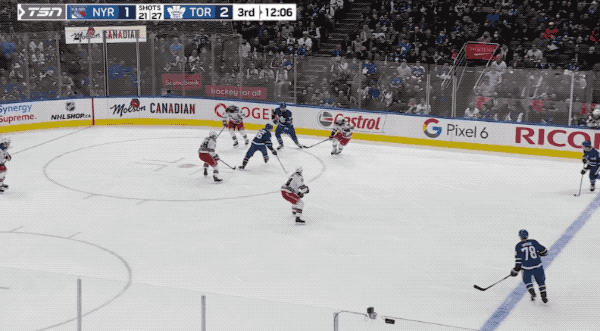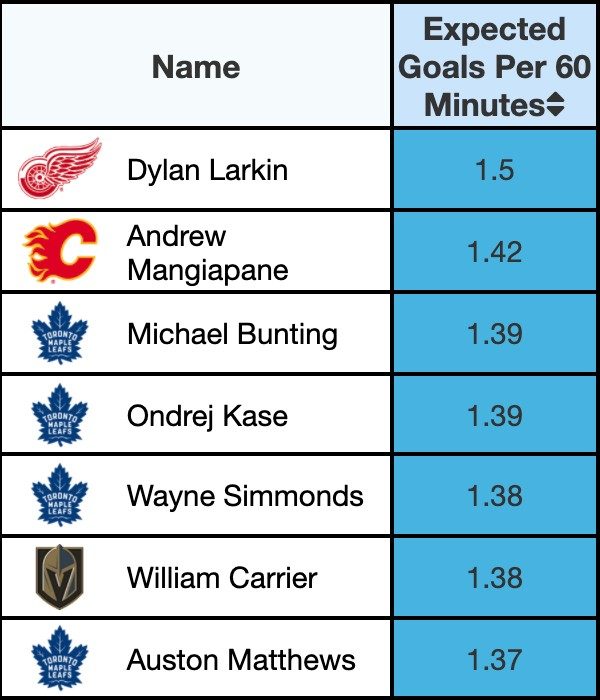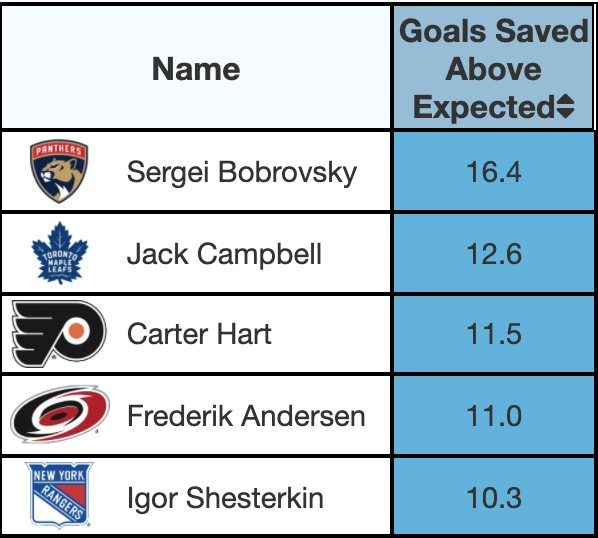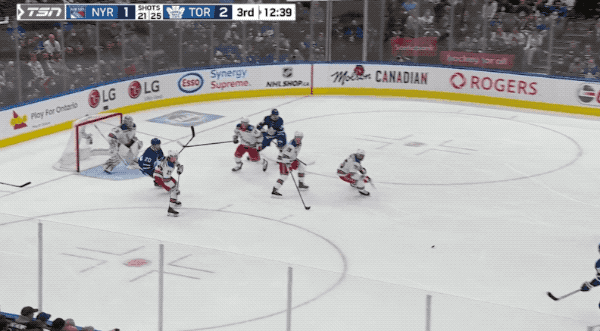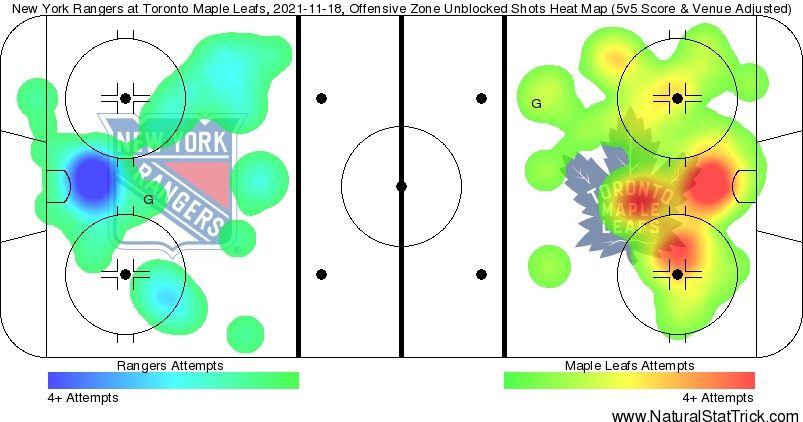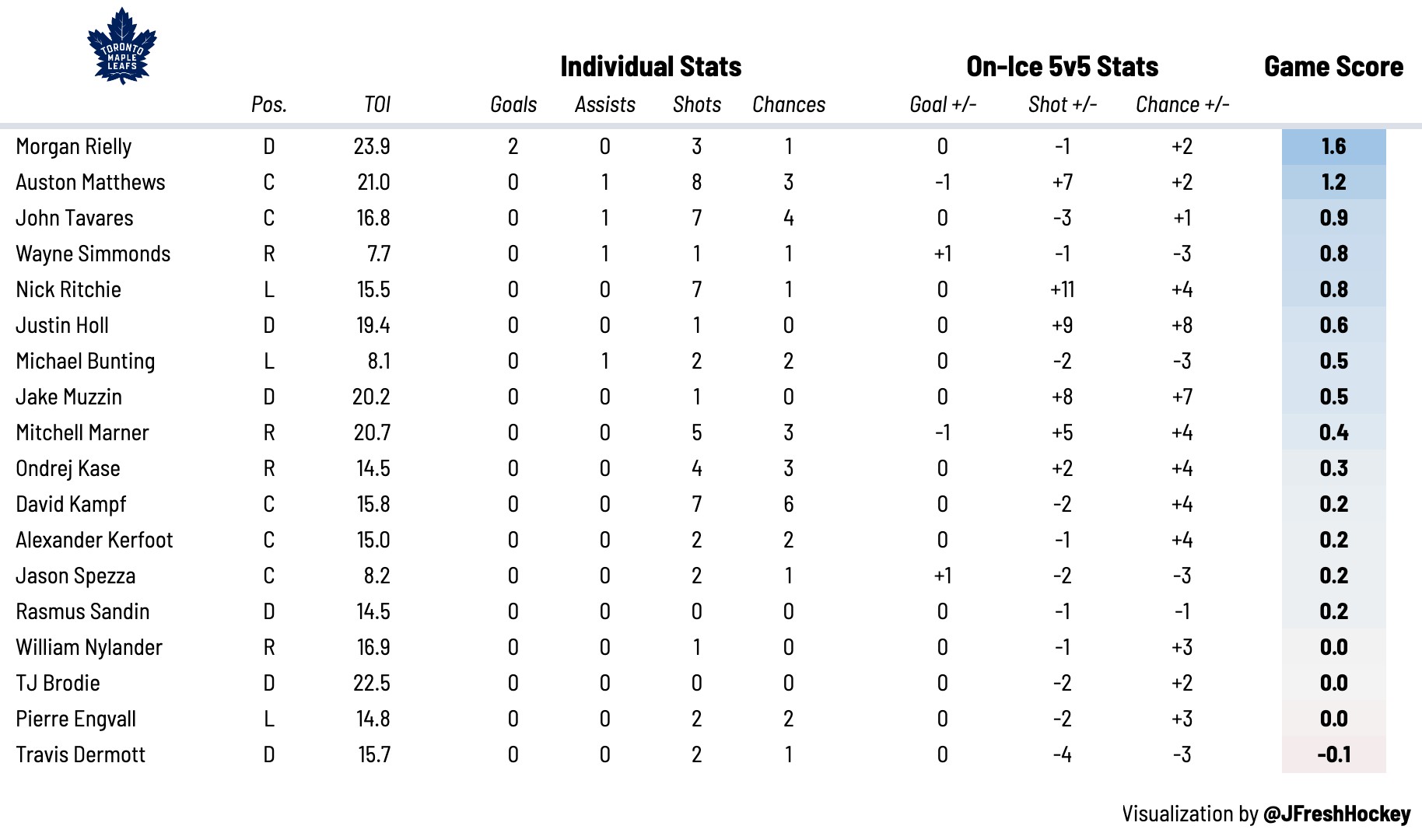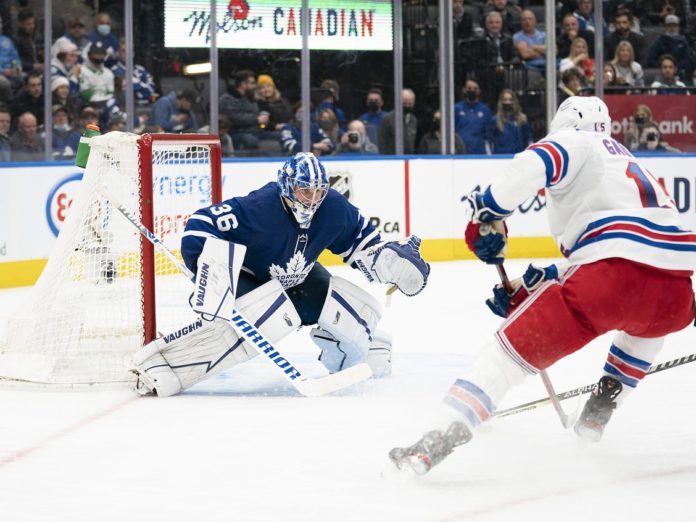
This team has been playing some excellent hockey lately.
With another win against the New York Rangers, that makes 10 out of their last 11 for Toronto. Many of us claimed we wouldn’t care about this regular season, but the Leafs are forcing all of us to pay attention with their play over the last month.
We’ve seen some lower-event games as of late, with Thursday night’s game against the Rangers being another example. That doesn’t mean it still can’t be great hockey, at least if you have a rooting interest in the Leafs, which I’d assume describes most of our readers.
Toronto controlled the run of scoring chances, yet again. It’s an area they’ve dominated all season, ranking first offensively in every predictive metric right now: shots, scoring chances, expected goals. The pucks haven’t been going in for a few key players, namely Auston Matthews, whose 4.6 shooting percentage at 5v5 is the lowest of his career by far.
The goals are obviously going to come, which turns our attention to defense. Toronto defended a one-goal lead in the third period and looked structured while doing it. In the last minute, they put their three young stars on the ice together and the did a great job limiting chances.
In these past few games, it’s been clear how much more “connected” the Leafs look as a five-man unit on the defensive side of the puck. This was my favourite quote from Sheldon Keefe:
“I just think we are far more connected in terms of the relationship between the forwards and the defensemen and how they are playing together. I also think that in general, our players are comfortable on the defensive side of the puck and aren’t forcing things on the offensive side.”
Defense isn’t sexy, but it wins championships, or so I’ve been told. To dive into this defensive affair in a bit more detail, let’s break down each player individually. It’s time for some Leafs Report Cards!
5 Stars
Morgan Rielly (LD, #44) — He really is the antithesis to everything I just described.
Rielly is an elite offensive player who can make great things happen when he’s jumping up in the play. He’s also been extremely productive on Toronto’s power play throughout his career; that’s where he picked up a goal in this game by walking into the slot and beating Igor Shesterkin five-hole.
Rielly also scored on a point shot that somehow made it through a screen and in. Those aren’t the highest xG plays in the world, but he’s always gotten pucks through at a high level relative to his teammates. It’s a valuable skill from the blue line, and he helped show off on that goal.
Goals and assists aren’t good measures of a defenseman (unless it’s for fantasy hockey), but the fact that Rielly is scoring at a near 60-point rate can’t be ignored. He isn’t relying on a shooting percentage bender as Alex Kerfoot has been lately. Rielly is actually driving a lot of the offense himself, most noticeably in transition but also off of the cycle when he starts roaming around the zone.
Part of the bed that you make with that playstyle is a tendency to jump up a lot, but this play below isn’t exactly a model of sound situational decision-making in the third period:
With Rielly, you have to take the good with the bad. The good was amazing on Thursday night and the bad was only somewhat bad, which is a huge net win. That’s the bet that you’re making with Rielly; that the good outweighs the bad. The good news is that he’s shown a consistent ability to elevate his play in the playoffs. The bad news is that he’s always given up a lot of quality chances against throughout his career.
I have such a tough time with these Rielly evaluations, but man, a lot happens when he’s on the ice. The Leafs got two goals from it in this game, so maybe I should shut up.
Wayne Simmonds (RW, #24) — We need to give this man some credit. He’s been one of the best players in the NHL at generating chances from the crease. Simmonds has earned those opportunities, fighting for the tough areas on the ice. Winning puck battles after the initial shot — “offensive rebounds” as I like to call them — is something he consistently does well in these tighter games. That’s how he picked up a primary assist on Rielly’s first goal.
Getting back to his scoring chances, one way of measuring that is expected goals, which rewards you with a higher value for shooting the puck from closer to the net.
You’ll find a lot of Leaf names near the top of the leaderboard.
Data from Moneypuck.com
I had my doubts, but Kyle Dubas & co. clearly did a great job identifying forwards who could generate these types of chances. My guess is those totals come down for everyone not named Auston Matthews, but it goes to show what going hard to the net alongside skilled players can do for you.
Well, Kase isn’t exactly playing with scoring skill, which brings us to his section.
The Czech Connection — When I heard that Ondrej Kase and David Kampf were childhood best friends, I thought it was adorable but also concerning that two players who didn’t seem to fit together skill-wise were going to be forced together as a pairing. “Kase is a legitimate top-six forward if he can stay healthy. Kampf is a defensive 4C. How the hell is that going to work?”
Well, apparently you dominate play at 5v5 even despite tough usage.
For what it’s worth, I think everyone is blowing their zone starts out of proportion. They start most of their shifts on the fly, but Kampf is clearly providing big-time value by preventing chances against.
gotta say david kampf has rly made me eat my words so far. did not expect him to look this effective AT all either just via the eye or the data pic.twitter.com/vOiikIz6Vh
— dylan (@dylanfremlin) November 19, 2021
That blue in front of his own net indicates that other teams aren’t generating much of anything when Kampf is on the ice. He gets those results by staying above his man in all three zones and using his long stick to generate takeaways.
Another interesting thing about Kampf is that he almost never turns the puck over. James Mirtle dove into some private data from InStat and found that he had one of the lowest turnover rates among forwards in the league, which matters when you pick the puck up in the defensive zone and don’t want to turn it over.
Kampf isn’t going to make many plays after crossing the offensive blue line, but by simply getting the puck there and away from his net, he’s doing his job as a defensive player. It shows in the results.
The last two games aside, the pucks haven’t been going in, and for Kampf, that’s been the case his entire career. Individually, he has the lowest expected Sh% in the NHL based on his history of not finishing. A few squeakers aside, I don’t think we should expect him to start scoring at a 20-goal rate any time soon. After all, he’s only scored 20 in his 253 NHL games.
Kase has scored at that rate throughout his career. He just can’t stay on the ice, which is always going to be our concern when we watch him go into every awkward collision. Bracing for potential injury is going to be part of life with Kase knowing the way he needs to play in order to be effective: forcing his way to the net and creating scoring chances out of nothing.
I’ll be praying for his health after every blocked shot and hard hit he takes — because he’s crucial towards driving the transition and offense on that third line.
Jack Campbell (G, #36) — Jack Campbell is rocking an otherworldly .944 save percentage this season. When you look at how many “expected goals” the Leafs should be giving up compared to what they’re actually giving up, Campbell has been in Vezina territory with his puck-stopping.
Is it likely to continue? I have no idea because… goalies. Carter Hart has yo-yoed from the top to the bottom of this list and back up again this year, as have Frederik Andersen and Sergei Bobrovsky. I’ll never pretend to understand this position, but Campbell has been playing the best hockey of his life lately.
4 Stars
Auston Matthews (C, #34) — This is weird. Anytime an elite scorer continues to generate quality chances and the goals don’t go in, it’s a really hard phenomenon to describe.
Matthews hasn’t stopped being an elite offensive player. At 5-on-5, he’s still getting quality looks like these with regularity. Some of them are wristers off the rush, backhanders, the “catch and shoot” release or the one-timer you see above, but he’s getting good chances every game.
The pucks just aren’t going in for him at even strength. I hate boiling the game of hockey down to puck luck, but if you’re telling me Auston Matthews has been playing poorly lately, I challenge you to bring up some evidence.
As Jason Spezza put it recently, Matthews’s goal-scoring is the least of Toronto’s concerns right now. Those pucks will find their way over the goal line eventually if Matthews keeps machine-gunning them to the net.
Alex Kerfoot (LW, #15) — Kerfoot has looked better lately. He seems to be using his speed in transition better, connecting on passes off the rush. From what all of us have been watching lately, he looks good and the production is there.
It needs to be kept in mind that he leads the Leafs in On-Ice Sh% by a mile. Whenever that happens, things usually regress to the mean and the player’s production drops to where it should be. He’s on a heater right now, but we shouldn’t expect this sudden rise in production to last.
It is also worth noting how strong he looked again on the penalty kill, breaking up plays with his speed and getting back to disrupt the entry on the backcheck. It’s legitimately very useful at 4v5, which is where the Leafs seem to value him most. He’s third on the depth chart behind Kampf and Marner.
3 Stars
Justin Holl (RD, #3) — This was the type of subtle Holl game I’ve come to appreciate. He didn’t make any big-time plays offensively, but he also didn’t get burned defensively, even if he did go a bit too far on his cross-checking penalty on Zibanejad. It’s Holl’s rush defense that matters more to me on the shutdown pair and he looked solid in that department against the Rangers.
Offensively, he was making the simple pass to the open man in the offensive zone, which is never the wrong play. Sometimes you just need a connector to complete the next play without turning it over, which is what Holl tends to do when he’s playing his best hockey. I still don’t think we’ve seen it yet, but he’s looking much smoother with the puck since coming back.
Nick Ritchie (LW, #20) — This is another weird one because it drives me insane when Ritchie goes into a board battle, doesn’t engage physically, and loses the 50-50 puck. It happens way more often than it should for a player of his size.
To some extent, though, Ritchie is getting screwed over by the Sh% gods. Toronto is scoring on less than 1% of their shots when he’s on the ice at 5v5. As bad as he’s looked at times, he really has been snakebitten offensively. More of his chances should’ve gone in by now, including his passes.
That’s the area of his game that stands out most to me on nights he’s playing well. For example, Ritchie made a great behind-the-net pass to Marner for a one-timer. That’s a high-percentage play, even if Marner is the one shooting it. Ritchie also boxed out Adam Fox and drove his way to the net for a chance on a partial breakaway.
Sticking with the theme in these report cards, those pucks are going to go in at some point. I refuse to believe in an On-Ice Sh% of 1 — it’s too absurd.
Michael Bunting (LW, #58) — How do you measure what he does? Hockey-wise, Bunting made a couple of nice plays; a drop-pass to Spezza off the rush; a good screen on Rielly’s goal. Yet all I can think about is him and Ryan Strome trying to kill each other.
John Tavares (C, #91) — This wasn’t Tavares’ most dangerous game offensively, although he did generate four chances from the slot. He was doing his usual quick, tight turns out of tough spots to make some plays with the puck.
2 Stars
Marner and Nylander — I love hearing Ray Ferraro do commentary. Sometimes I can sit back and let him do the analysis much better than I ever could. He mentioned that Mitch Marner and William Nylander struggled to make plays in open ice last night, with things being really tight in the neutral zone.
That’s literally your job as an elite puck-carrier: to slice your way through that neutral zone trap and advance play up the ice with possession. They didn’t accomplish that at 5v5. The good news is that the Leafs received offensive contributions from a depth line (leading to the first goal) and their blue line on an off-night for their two best wingers.
On the power play, things started off with Marner on the left-wall and Nylander on the goal-line. I’d argue they looked their most dangerous when Marner worked his way down to the goal line.
I’d like to see them start the formation this way since it seems to be their most consistent way of generating good looks.
Sandin-Dermott — A sheltered pairing shouldn’t be getting outshot and outchanced when the rest of their teammates controlled the run of play. That’s a below-average night for these two. They did have a few nice moments on the breakout with their quick puck-moving.
Jason Spezza (C, #19) — I’ve been bringing up Spezza’s offensive value for a while now. He led the team in Points per 60 at 5v5 and 5v4 last year. He leads the NHL in slot passes per 60 right now. I really like this player.
I’m also wondering if it might be time for him to take a night off. In other sports, we’ve seen how helpful it can be for a 38-year-old to play fewer than three games a week in the 6-month slog we call a regular season. As Anthony wrote earlier this week, a few more minutes when Spezza does play paired with the odd night off might be the best of both worlds in terms of managing the load while maximizing his offensive value.
He hasn’t had as much burst in his skating as we saw to start the year. He’s at his best when he can load up in his own end and attack skating north up the ice.
Jake Muzzin (LD, #8) — The numbers were good when Muzzin was on the ice, so maybe this is a terrible eye-test evaluation. His puck-moving still isn’t pretty, but his breakout numbers were awful last season and he still managed to get results against top competition at 5v5 by doing other things, namely without the puck.
We should be watching for plays he’s making when he’s away from the puck. Maybe I missed some of the little nuances in his game while trying to keep up with the other skaters on the ice, but I saw Muzzin getting beat badly a few times. He avoided penalties on a few plays that didn’t get called, dragging down Adam Fox on one play and slashing Julien Gauthier on another.
It’s possible I’m “big mistaking” him here, but I find myself wanting more from Muzzin’s overall game. When he solidifies himself as the elite 5v5 defender we know he can be, this team could become a 200-foot juggernaut. That’s right, I said it. Muzzin’s not there yet, though.
TJ Brodie (RD, #78) — While his game is in a considerably better place than it was at the start of the year, I don’t think Brodie’s fully there yet, either. His defense has looked much improved lately as the complement to Rielly’s aggressive game — his transition defense has helped bail Toronto out of a bunch of jams, including on the nearly-free-and-clear Artemi Panarin with the game at 2-1 in the third period — but his ability to transition play up the ice has been concerning this year.
Even on simple breakouts, Brodie appears to have trouble completing anything other than a D-to-D pass. Whenever he tries to make a play “north” up the ice, the completion percentage doesn’t tend to be very high on those passes. It helps when you can just defer to Rielly, but we’ve seen Brodie look much smoother on the breakout before. I’d like to see more of that player.
Pierre Engvall (LW, #47) — Speaking of the difference between the player you want to see and the player you’re actually seeing, it’s time to talk about Pierre Engvall.
Few players confound me more than him. He’s scored at a third-line rate throughout his career, doesn’t allow many chances against when he’s on the ice, and yet, you find yourself yelling at the TV every time he touches the puck.
Maybe our eyes are deceiving us with the 6’5 giraffe? Maybe we want him to be more and he just is. He “is” a third-line NHL forward, which tend to be guys who frustrate you (see Kerfoot, Alex).
If I can give Engvall credit for the things he can do — getting his long stick on pucks on the forecheck, using his speed to transport the puck up the ice, while staying above his man in all three zones — I’d probably appreciate him much more.
But I can’t do that.
I keep seeing the player who makes the wrong decision with his great tools and it drives me insane. It drives Sheldon Keefe insane. Is this a bias in player evaluation or is there genuinely more value to extract out of Engvall? I wish I knew the answer.
Heat Map
Here’s a quick look at where each team’s shots were coming from at even strength, courtesy of Natural Stat Trick.
The Leafs controlled 55 percent of the shots and 58 percent of the scoring chances at 5v5 in this game. The Deserve To Win O’Meter was well in their favour tonight.
Game Score
Game score is a metric developed by The Athletic’s Dom Luszczyszyn to measure single-game performance. You can read more about it here.
Tweets of the Night
Took 'em a while but the Leafs are finally playing Lou Lamoriello hockey
— Arthur Staple (@StapeAthletic) November 19, 2021
What does this even mean?
“Leafs top 4 guys aren’t scoring”
Top guys score 14 consecutive goals“Okay but the depth is bad”
Kerfoot, kampf, kase, spezza provide secondary scoring“No goals from the defense”
Rielly promptly scores two.How is the media gonna shift the goal posts now for this team
— Bunting for calder (@jihad_raya_) November 19, 2021
“Now let’s see them do it in the playoffs.”
Ondřej Kaše & David Kämpf played together their whole life on one line on all levels & are best friends ever since children. Duo got separated when Kaše got drafted and moved to NA with Ducks. Now reunited, those two are providing absolutely ridiculous amount of value for Leafs. pic.twitter.com/jLZWYv3Zlp
— Sam Tirpák (@SammyT_51) November 17, 2021
I wanted to make fun of it. I was wrong.























